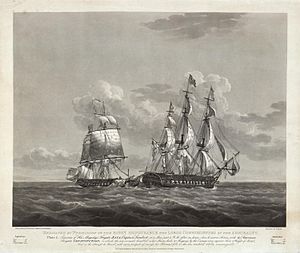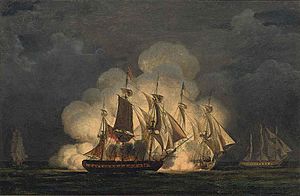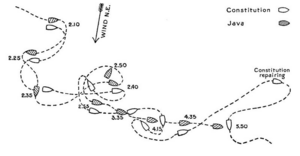HMS Java (1811) facts for kids

USS Constitution capturing HMS Java
|
|
Quick facts for kids History |
|
|---|---|
| Name | Renommée |
| Ordered | 26 March 1805 |
| Builder | Mathurin & Antoine Crucy, Basse-Indre Nantes |
| Laid down | October 1805 |
| Launched | 20 August 1808 |
| Captured | 20 May 1811 |
| Name | HMS Java |
| Acquired | 20 May 1811 |
| In service | May 1811 |
| Captured | 29 December 1812 |
| Fate | Burnt on 1 January 1813 |
| General characteristics | |
| Class and type | Pallas-class fifth-rate frigate |
| Tons burthen | 1073 41⁄94 (bm) |
| Length | 152 ft 5+1⁄2 in (46.5 m) (gundeck); 126 ft 5+1⁄2 in (38.5 m) (keel) |
| Beam | 39 ft 11+3⁄8 in (12.2 m) |
| Depth of hold | 12 ft 9 in (3.9 m) |
| Sail plan | Full-rigged ship |
| Complement | 397 |
| Armament |
|
HMS Java was a British Royal Navy warship. It was a 38-gun frigate, which is a type of fast sailing warship. Originally, it was built in France in 1805 for the French Navy and called Renommée. Even though it was described as having 40 guns, it actually carried 46. The British captured this ship in 1811 during a battle called the Battle of Tamatave. However, Java is most famous for its defeat on December 29, 1812. This was a three-hour battle against the American ship USS Constitution. Java usually had about 277 crew members, but during its fight with Constitution, it had around 426 people on board. The Constitution had 475 crew members.
Contents
The Java's Early Life in France
In May 1811, the Renommée was part of a group of three French ships. This group was carrying soldiers to Mauritius. On May 20, the French ships met a group of British ships. In the battle that followed, called the Battle of Tamatave, the Renommée was badly damaged. Its main sail caught fire, and the ship had to surrender.
The British captured the Renommée and another French ship, Néréide, a few days later. The third French ship, Clorinde, managed to escape. The British then added Renommée to their own navy and renamed it HMS Java.
In July, Captain William Gordon was in charge of Java. However, it wasn't officially ready for duty until August. That's when Captain Henry Lambert took command. Captain Lambert was a very experienced officer who had fought in many battles for the British Navy.
On November 12, Java left Portsmouth, England. Its mission was to sail to Bombay (now Mumbai) in India. On board, it carried the new governor, Lieutenant-General Sir Thomas Hislop, and his team. It also carried their luggage and important naval supplies. These supplies included copper plates and plans for new ships being built in Bombay. The ship also had extra crew members who were traveling to join other ships.
The Famous Battle with USS Constitution
Captain Lambert of Java was a skilled leader. His ship, Java, had a full crew. However, many of them were new sailors who had not spent much time at sea. They had only practiced firing their cannons once, and without cannonballs! Still, Java was well-supplied and would prove to be a brave fighting ship.
The American ship, USS Constitution, was a very strong frigate. It had an experienced crew and carried 54 cannons. These included thirty 24-pounder guns and twenty-four 32-pounder carronades (a type of short cannon). It also had two 24-pounder cannons at the front for chasing other ships.
On December 13, 1812, the USS Constitution was sailing near Brazil. On December 29, at 9:00 AM, the crew spotted other ships far away. Captain William Bainbridge of Constitution wasn't sure if they were friendly or enemy ships at first. As they got closer, he realized they were large and likely British. Both ships raised their signal flags, but neither recognized the other's signals.
The Constitution sailed away from neutral waters, with Java chasing it. At 12:30 PM, Java raised its flags, and Constitution did the same. Now, both ships knew they were enemies. Java had the "weather gauge," meaning it was in a better position because of the wind. This allowed it to try and fire along the length of Constitution. Since Java was built in France, it was lighter and faster than Constitution. Constitution fired a warning shot, and Java responded with a full "broadside" (all cannons on one side firing at once).
The Battle Begins
Java started the battle at a disadvantage. Its crew was less experienced, and its cannons fired lighter cannonballs than Constitution's. The Constitution, with its experienced captain and crew, fought smartly. It did not shorten its sails, which was unusual. This made it risk losing its masts but allowed it to keep moving fast.
By 2:00 PM, both ships were sailing in the same direction. In the beginning, both ships tried to get into the best position to fire at each other, but it was difficult. Captain Bainbridge then turned Constitution to match Java's course and fired a broadside from about half a mile away. This shot missed, forcing Bainbridge to take a risk to get closer to Java.
Another broadside from Java hit Constitution's steering wheel, damaging its rudder. Captain Bainbridge was badly hurt, but he refused to leave his command. Both ships continued to fire their cannons. By now, Java had a mast and sail falling over its side. This stopped most of its cannons on that side from firing. When they tried to fire, they only set the fallen sails on fire.
The End of Java
The Constitutions accurate shots and heavier cannons gave it a big advantage. Within an hour, after several close calls where the ships' ropes and sails got tangled, Javas masts collapsed. During this time, a sharpshooter on Constitution shot Captain Lambert, who later died from his wounds.
Lieutenant Henry Ducie Chads took over command of Java. Captain Bainbridge used this chance to move Constitution away and make quick repairs. This took about an hour. The crew on Java had barely started clearing their fallen masts when Constitution returned. The American ship took a position where it could fire along Java's length, and Java could not defend itself. Lieutenant Chads had no choice but to surrender Java.
In the battle, Java lost 22 men, including Captain Lambert, and 102 were wounded. Constitution lost nine men and 57 were wounded, including Captain Bainbridge. Some of the wounded later died.
Java was so badly damaged that it was just a broken hull. It was not worth keeping as a captured ship. Instead, Captain Bainbridge removed its steering wheel and put it on Constitution, replacing the one that had been shot off. On New Year's Day 1813, two days after the battle, Bainbridge ordered Java to be set on fire. It then exploded.
When Captain Bainbridge heard about Captain Lambert's death, he was very sad. He said Lambert was a brave and noble commander. On April 23, 1813, Lieutenant Chads and the other surviving officers and men of Java had a court martial (a military trial) for losing their ship. They were found to have fought honorably and were cleared of any blame.
Java in Books
The battle between Java and Constitution was written about in the novel The Fortune of War by Patrick O'Brian.




